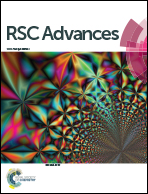Large mesoporous carbons decorated with silver and gold nanoparticles by a self-assembly method: enhanced electrocatalytic activity for H2O2 electroreduction and sodium nitrite electrooxidation†
Abstract
We report here the synthesis of silver and gold nanoparticles onto poly (diallyldimethyl ammoniumchloride, PDDA)-functionalized large mesoporous carbon (LMC) by a simple self-assembly method. Characterization of these nanocomposites by transmission electronic microscopy and electrochemical techniques is described. The gold nanoparticle-decorated PDDA-functionalized LMC (AuNPs/PDDA–LMC) showed an enhanced electrocatalytic response toward sodium nitrite oxidation with a wider linear range and higher sensitivity that is even comparable with Pt-based sensors. The silver nanoparticle-decorated PDDA-functionalized LMC (AgNPs/PDDA–LMC) exhibited a remarkable catalytic performance toward H2O2 reduction. At an applied potential of −0.4 V, the designed sensor had a low detection limit of 6.5 μM and wide linear response range from 20 μM to 9.62 mM with a fast response time of less than 2 s. The easy fabrication and excellent electrocatalytic capability of the LMC-based metal nanoparticle hybrids can be expected to be applied in the detection of other compounds.


 Please wait while we load your content...
Please wait while we load your content...